This post may contain affiliate links. See my disclosure policy.
With the right water-to-rice ratio, you’ll have perfectly fluffy and fragrant Jasmine Rice every time. This easy recipe will make you a rice-cooking pro in no time!
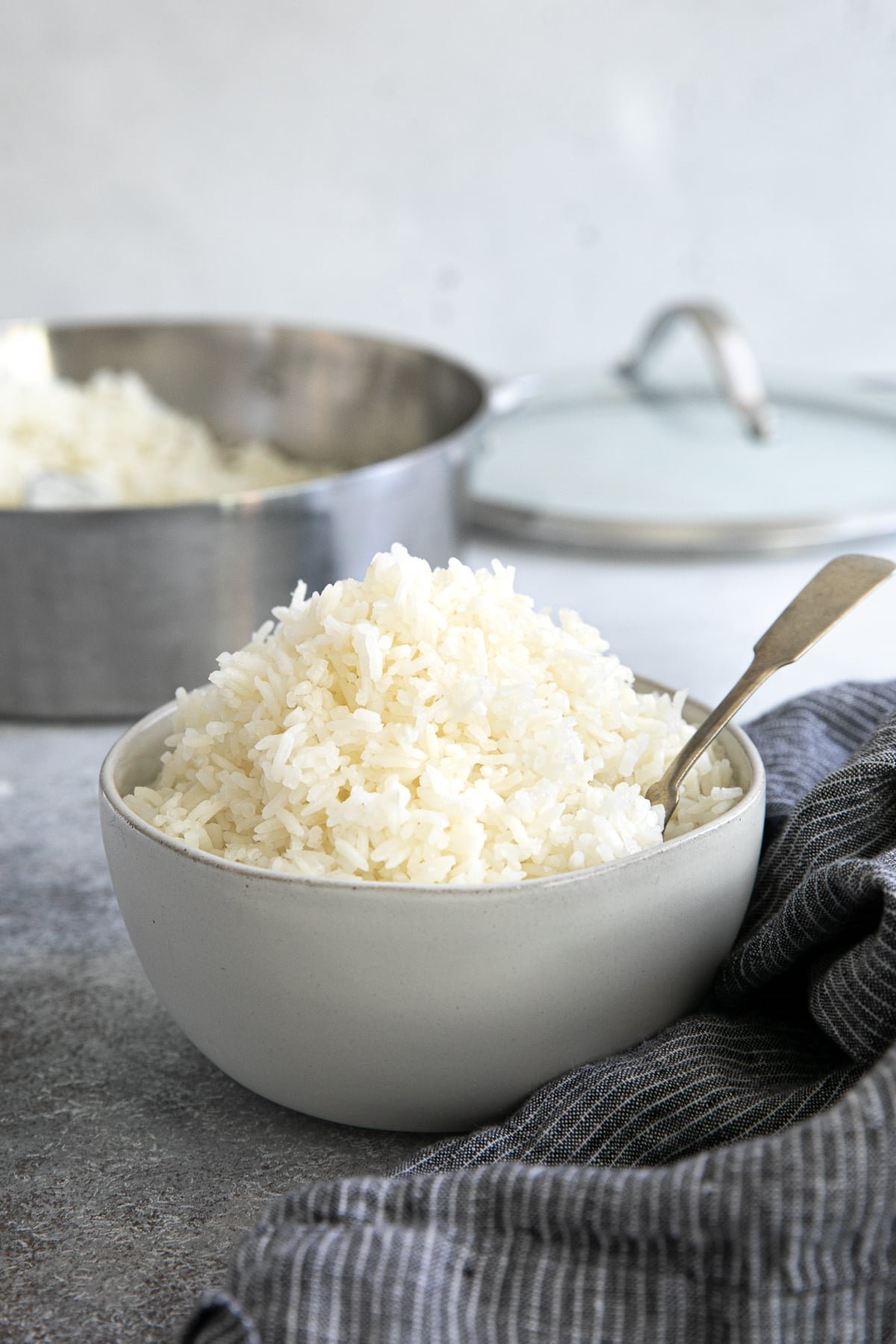
Perfect Jasmine Rice
Like cooking basmati rice on the stovetop, the key to cooking perfectly fluffy jasmine rice comes down to finding the right water-to-rice ratio. Hint- the package instructions are usually wrong. Jasmine rice requires even less water than regular white rice, just one and a third cups for every cup of dry rice.
Table of Contents
What is Jasmine Rice?
Named after the delicious-smelling jasmine flower, jasmine rice is originally from Thailand and is most commonly used in Southeast Asian cooking like this coconut rice recipe. A type of long-grain rice, the grains are slightly shorter and thicker when compared to basmati rice and become moist and somewhat sticky after cooking. Thorough rinsing to remove dirt and surface starch is highly recommended. Most major supermarkets sell both brown jasmine rice and white jasmine rice.
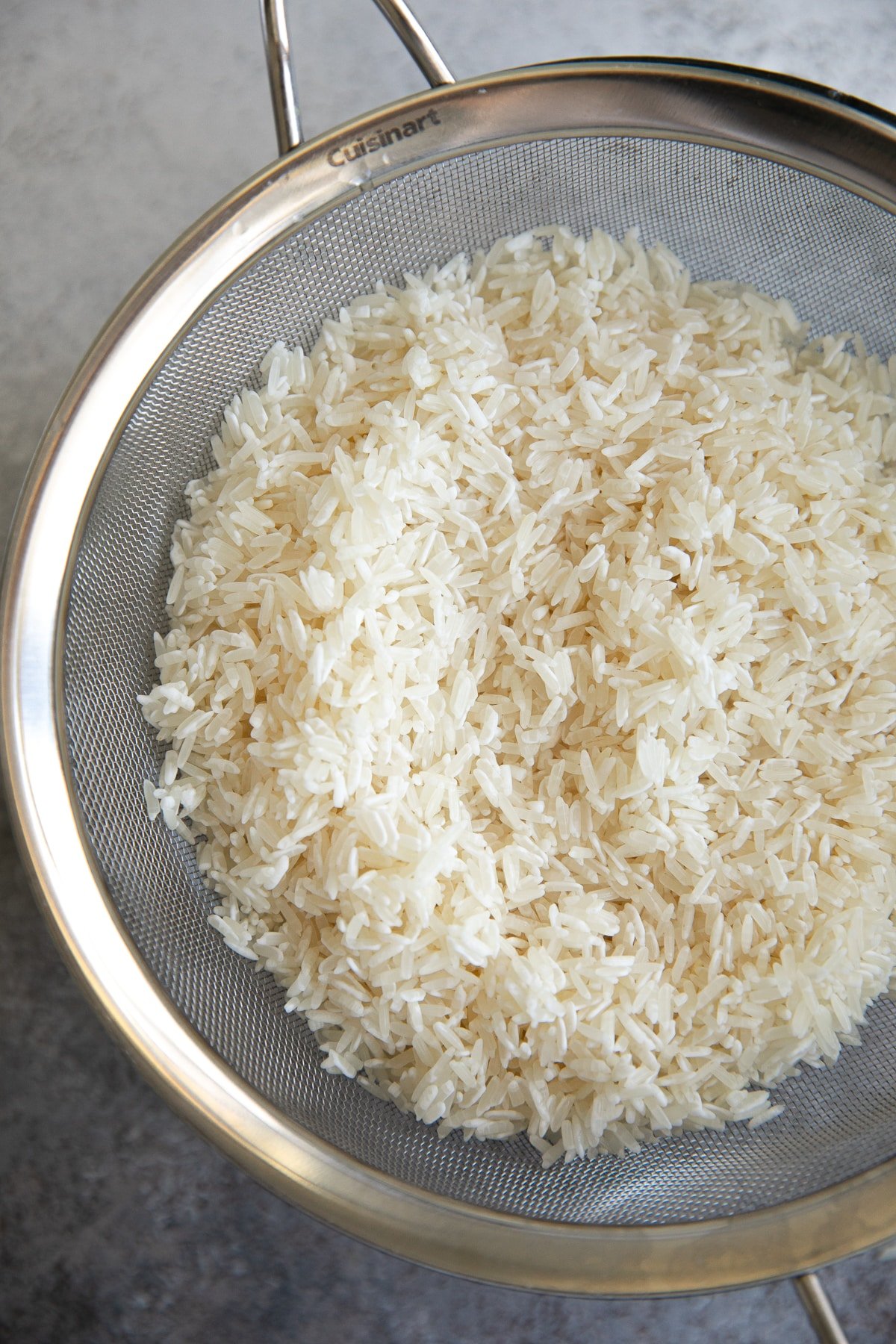
How to Cook Jasmine Rice
1. Wash and soak the rice: Wash the rice in several changes of cold water. Rinsing the rice removes some of the excess starch, making fluffier, less sticky rice. Transfer the rice to a medium bowl filled with cold water. Soak for 20-30 minutes, time allowing. Soaking is optional.
2. Drain the rice: Drain the rice in a fine-mesh strainer. To remove excess water, I like to rest the rice-filled fine-mesh strainer on top of a kitchen towel and carefully tap to remove any excess water clinging to the grains. Keep in mind that any extra water that isn’t drained away will make its way to your pot, throwing off the water to rice ratio.
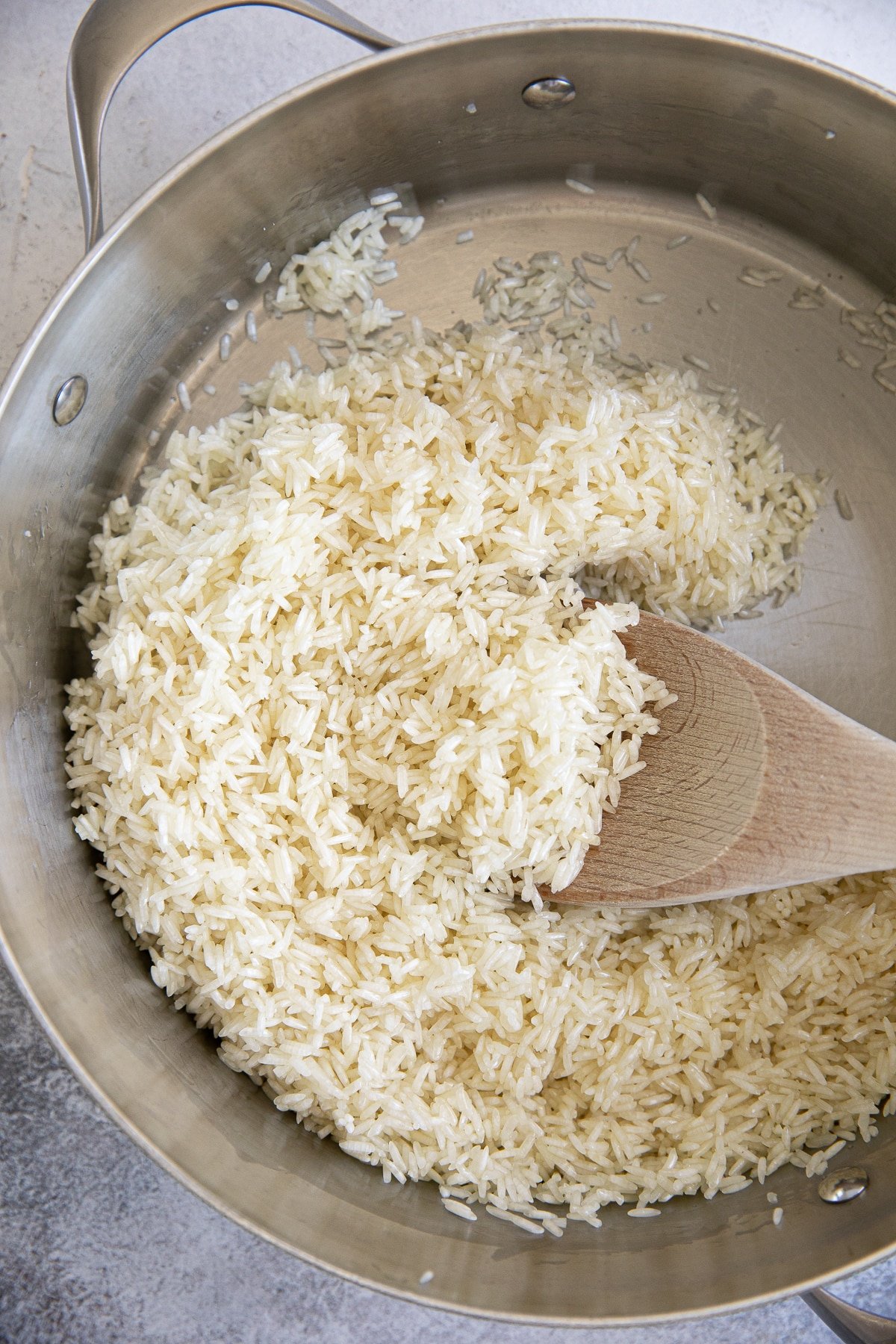
3. Boil the water or cooking liquid: Pre-boil the water (or chicken broth). You may use an electric or stovetop kettle or an old-fashioned pot. For every 1 cup of uncooked rice, you will need 1⅓ cups of water (just boiled).
4. Toast the rice (optional): Heat the olive oil (or butter) in a wide saucepot or pan over medium heat. Add the rinsed rice and a pinch of salt. Thoroughly mix the rice so that each grain is covered in oil.
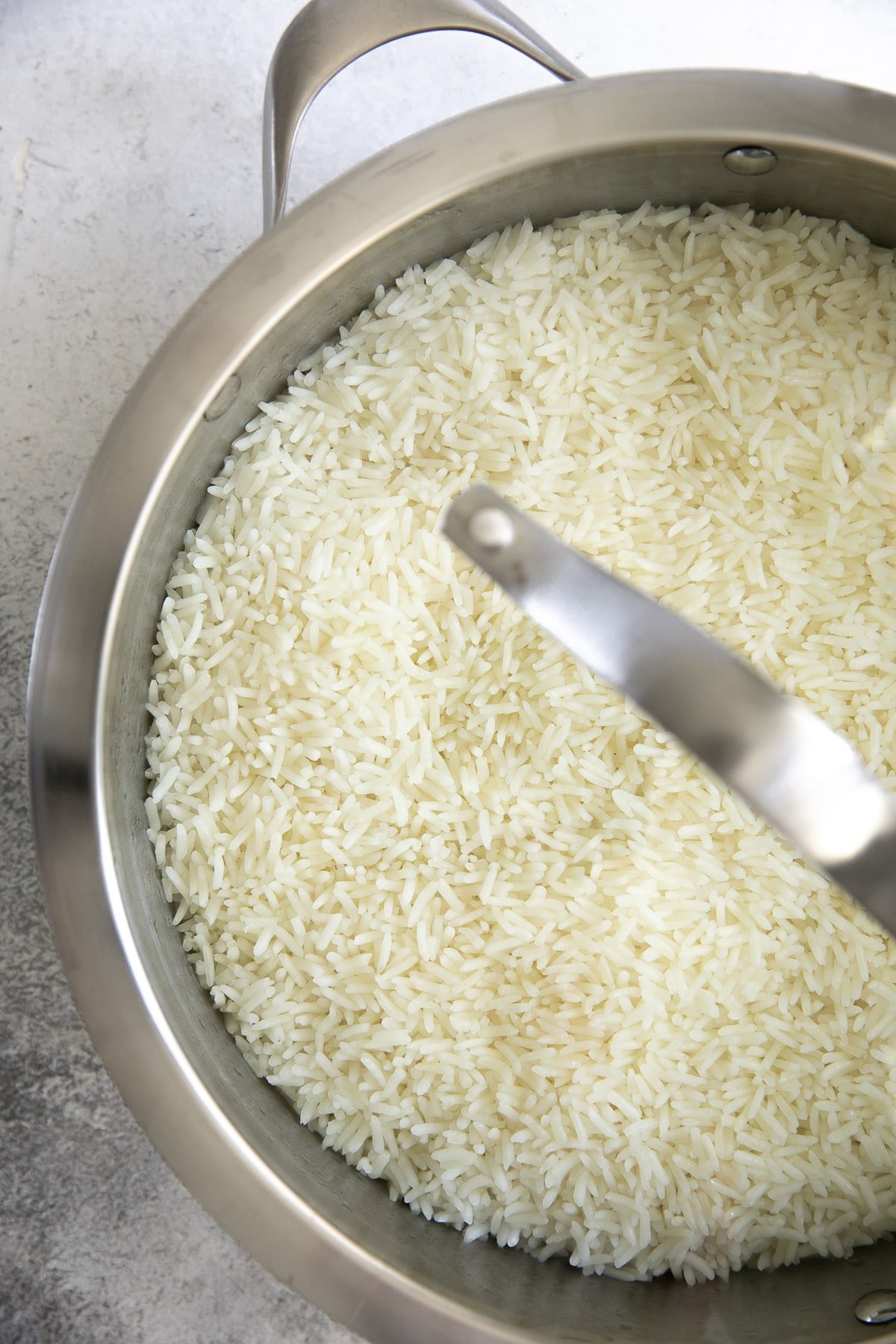
5. Add the liquid and cook the rice: Add the boiled water (or stock) and increase the stovetop to medium-high heat. Bring to a boil, immediately reduce heat to low, and cover with a tight-fitting lid. Leave the rice to cook for 10-12 minutes without lifting the lid.
- Tip – If you have a clear glass lid, you can check for doneness by carefully tilting the pan (with the lid still in place) to one side. If you see a pool of extra liquid, you know to keep cooking. If no liquid is visible, it indicates that most of the liquid has been absorbed.
6. Steam: Remove from heat and allow the rice to steam, undisturbed, for 10-15 minutes. Do not remove the lid. Before serving, gently fluff with a fork and dot with 1-2 tablespoons of butter, if desired.
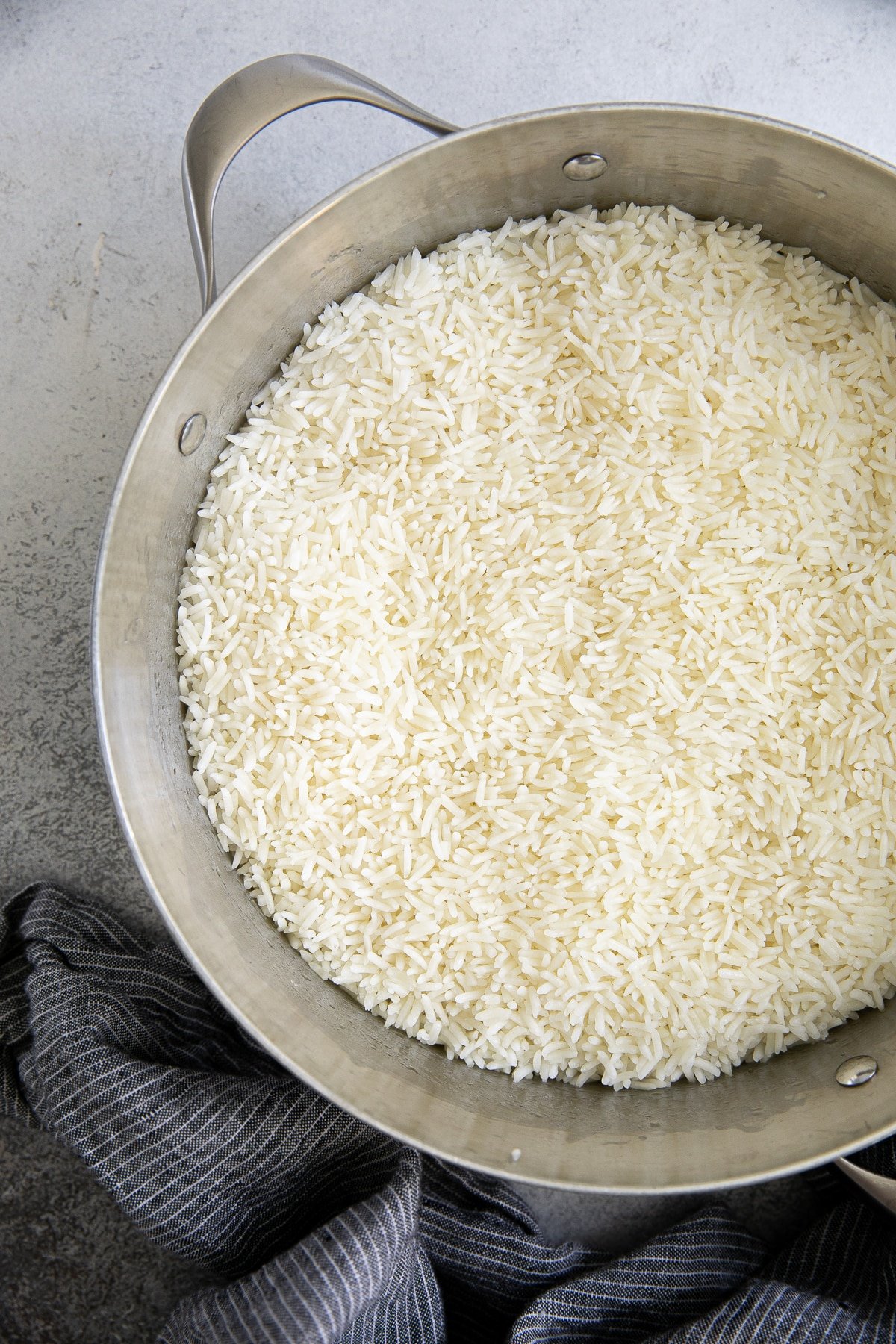
Frequently Asked Questions
Yes. All types of rice, including jasmine rice, are 100% gluten-free.
The reason for washing rice is not just to get it clean (yes, very important) but, more importantly, to remove the surface starch from the rice. Skip this step; no matter how well you cook your rice, it is more likely to turn out clumpy and gummy.
You do not need to soak your rice before cooking – especially if you’re short on time. The primary reason for soaking rice is to speed up cooking time.
One and one-third cups of water are needed to cook one cup of rice on the stovetop.
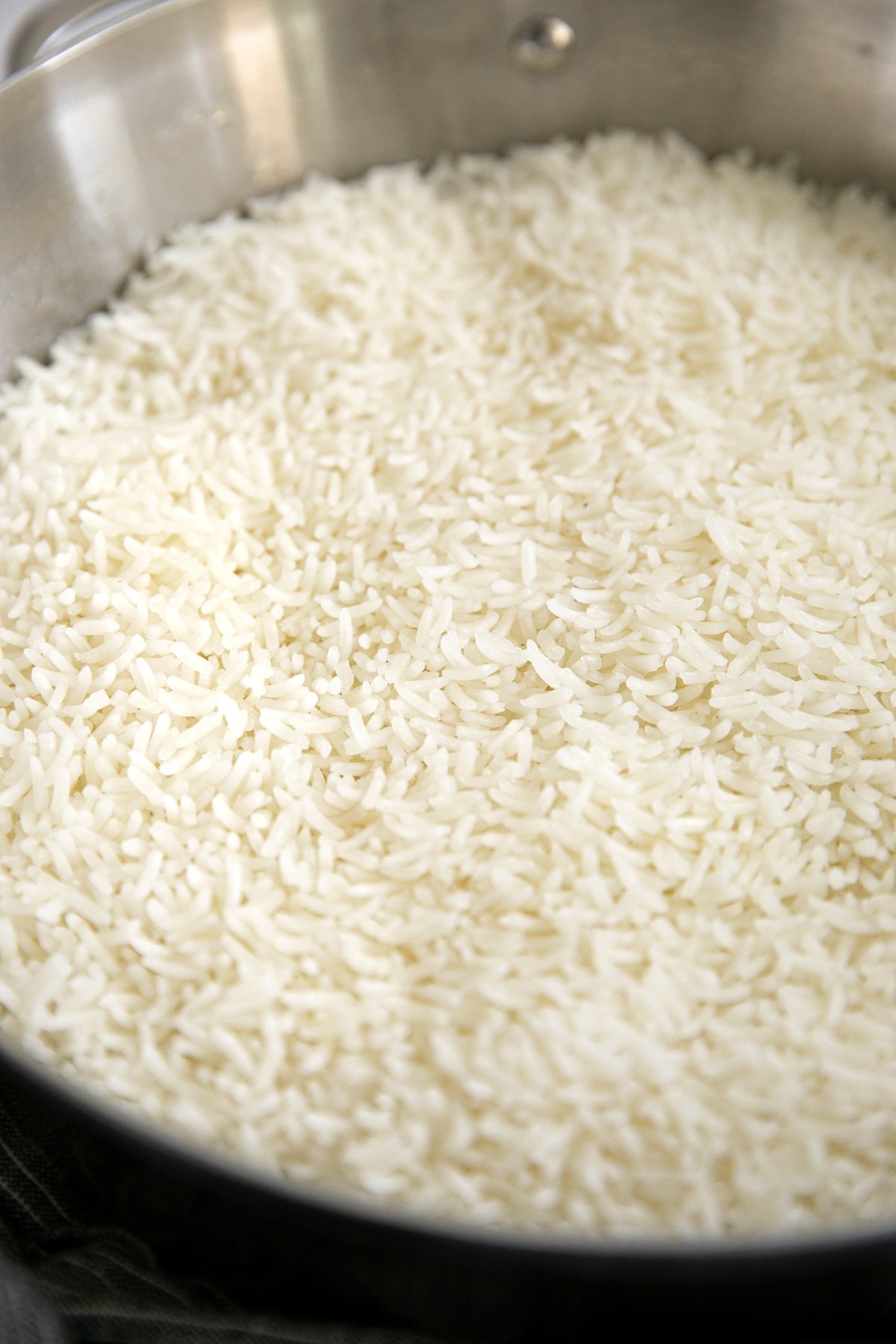
Other Cooking Methods For Jasmine Rice
Jasmine rice can also be cooked via the Instant Pot or the “pasta” cooking method. Check out my Instant Pot white rice and Instant Pot brown rice for more information. The water to rice ratio for white jasmine rice and brown jasmine rice in the Instant Pot is 1:1 or 1 cup of water for every 1 cup.
To cook jasmine rice using the “pasta method,” follow these easy instructions,
- Thoroughly wash your rice. For this method, you do not need to measure out the rice (unless you want/need to).
- Transfer the washed rice to a medium saucepan or pot and fill with enough water to cover by at least 1-inch (again, no need to measure the amount of water). Add a pinch of salt and stir.
- Bring the water to a boil over high heat. Once the water comes to a boil, reduce heat to low and cover the pot with a tight-fitting lid.
- Check the progress of the rice every 5 minutes. If you can squish it between your fingers, it’s done. Drain any excess water from the rice (there will be water leftover) and rinse with warm water. Drain again and transfer back to the pot. Just like pasta, avoid over-cooking your rice.
Read more about this pasta-like cooking method in this post all about cooking rice.
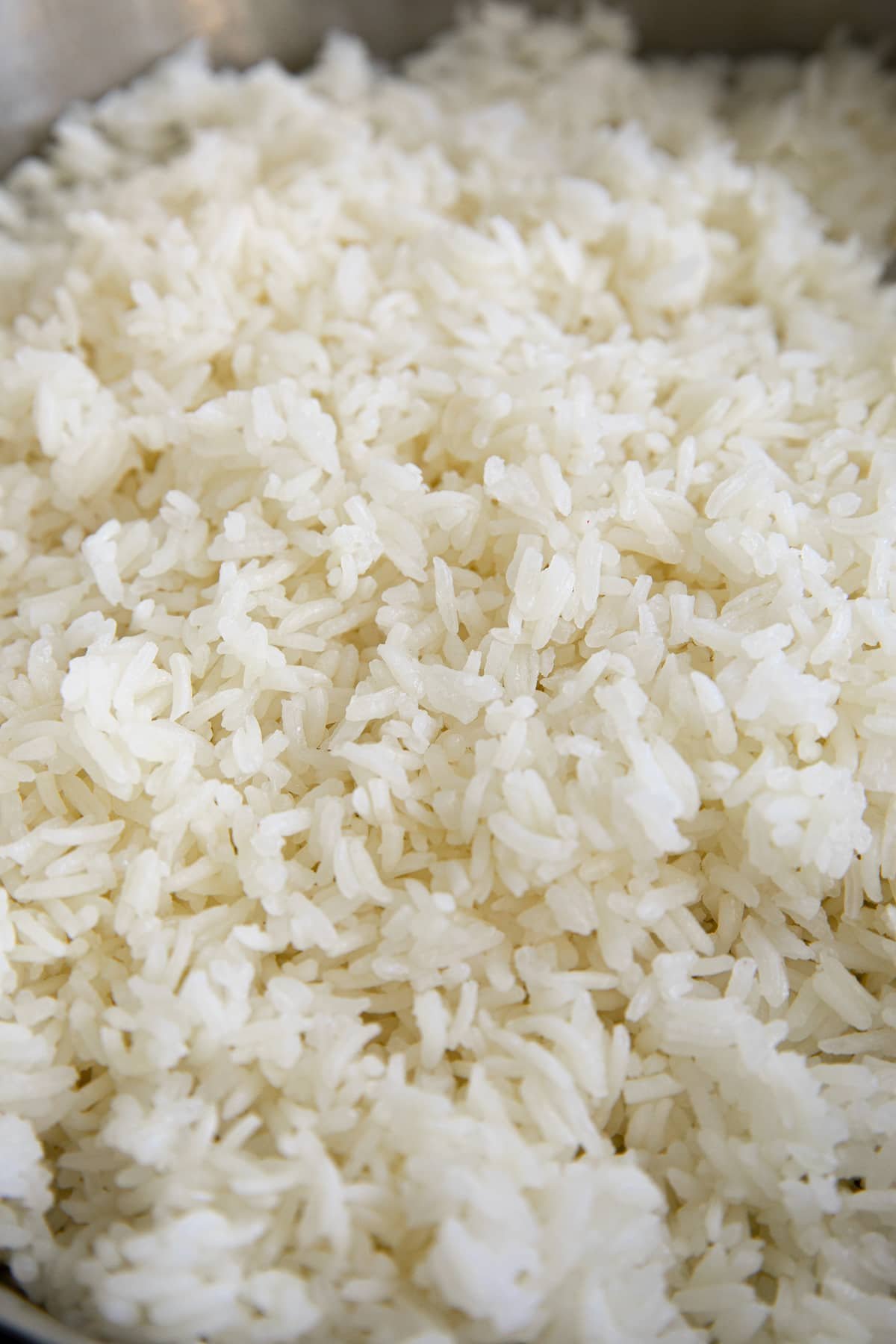
How to Serve
Jasmine rice pairs best with Southeast Asian recipes, including curries, stir-fry, and meat dishes. Its nutty taste and aroma make it a delicious base for stand-alone rice recipes like this coconut rice or fried rice recipe. You’ll almost always find a big serving of jasmine rice paired with your favorite Thai cuisine, including pad see ew, Thai basil chicken (pad kra pao gai), and pineapple coconut fish curry.
More Delicious Rice Recipes,
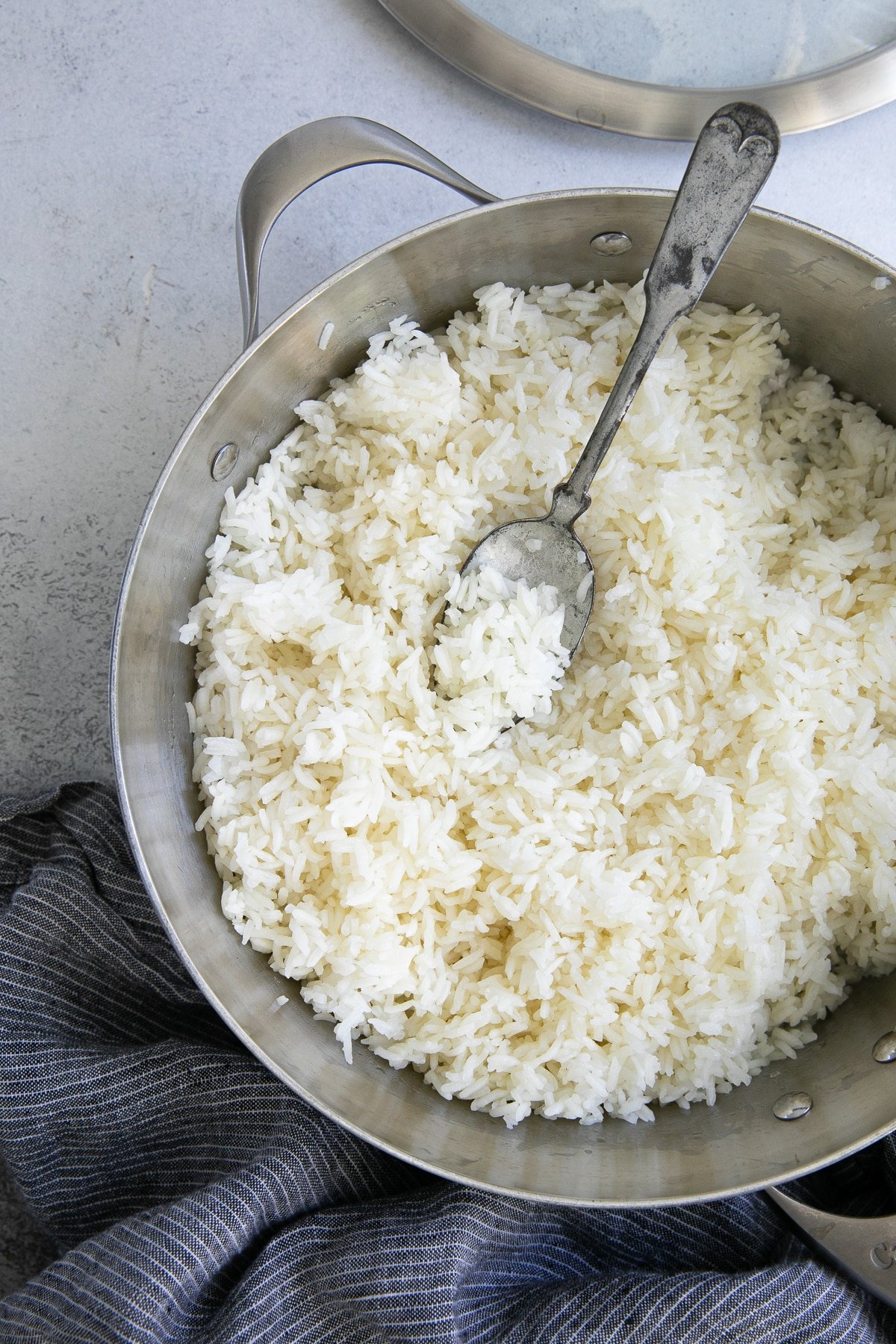
Have you tried making Jasmine Rice?
Tell me about it in the comments below! I always love to hear your thoughts. And tag me #theforkedspoon on Instagram if you’ve made any of my recipes. I always love to see what you’re cooking in the kitchen.

How to Cook Jasmine Rice Recipe
Ingredients
- 1 cup Jasmine rice
- 2 teaspoon oil
- 1⅓ cups water, (or chicken broth)
- pinch of salt, (optional)
Instructions
- Wash the rice in several changes of cold water or until the water runs nearly clear. Thoroughly washing the rice removes dirt and surface starch, making fluffier, less sticky rice.
- Transfer the rice to a medium bowl and fill it with cold water. Allow your rice to soak for 20-30 minutes (time allowing).
- Thoroughly drain the rice in a fine-mesh strainer. To help remove some of the excess water, I like to rest the rice-filled fine-mesh strainer on top of a kitchen towel and carefully tap to remove any excess water.
- Boil the water (or chicken broth). You may use an electric or stovetop kettle or old-fashioned pot. You will need 1⅓ cups of just-boiled liquid. You may measure the exact amount, being extra careful not to let any evaporation occur, or boil a bit extra and measure the boiling liquid just before adding to the rice.
- Toast the rice (optional) – Heat the olive oil (or butter) in a wide, lidded saucepot or pan over medium heat. Add the rice and a pinch of salt. Thoroughly mix the rice so that each grain is covered in oil (I like using a stainless steel pot with a glass lid whenever I make rice).
- Add the boiled water (or stock) and increase to medium-high heat. Bring to a boil, immediately reduce heat to low, and cover with a lid. Leave the rice to cook for 10-12 minutes without lifting the lid (see notes).
- Without removing the lid, remove from heat and allow the rice to steam, undisturbed, for 10-15 minutes. Just before serving, fluff with a fork and dot with 1-2 tablespoons of butter, if desired.
Notes
Nutrition
Nutrition information is automatically calculated, so should only be used as an approximation.
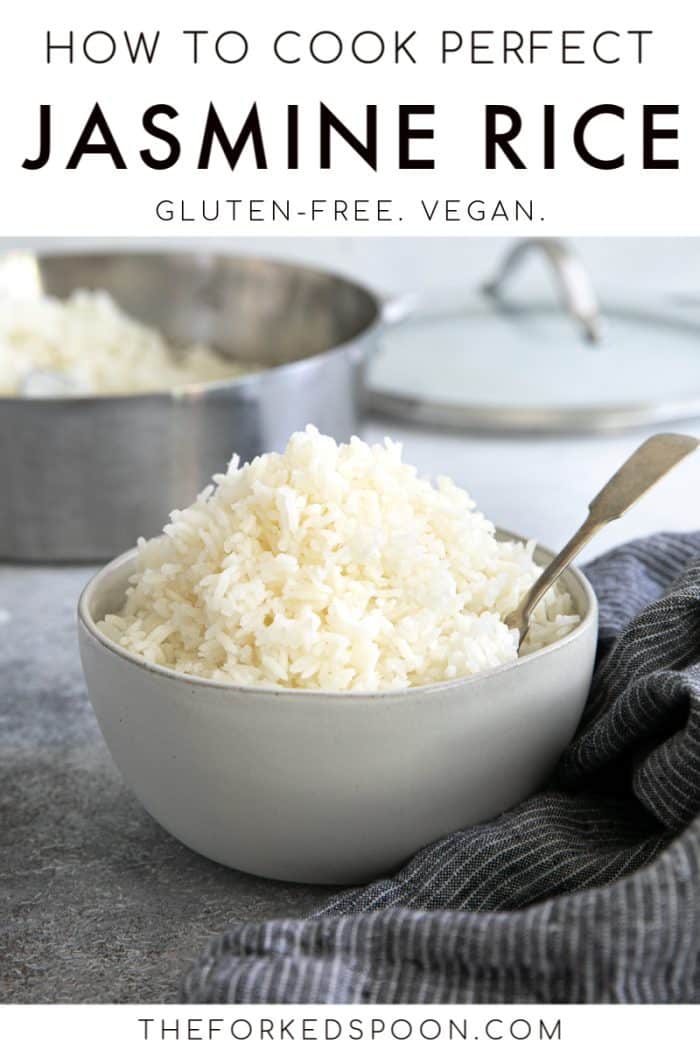
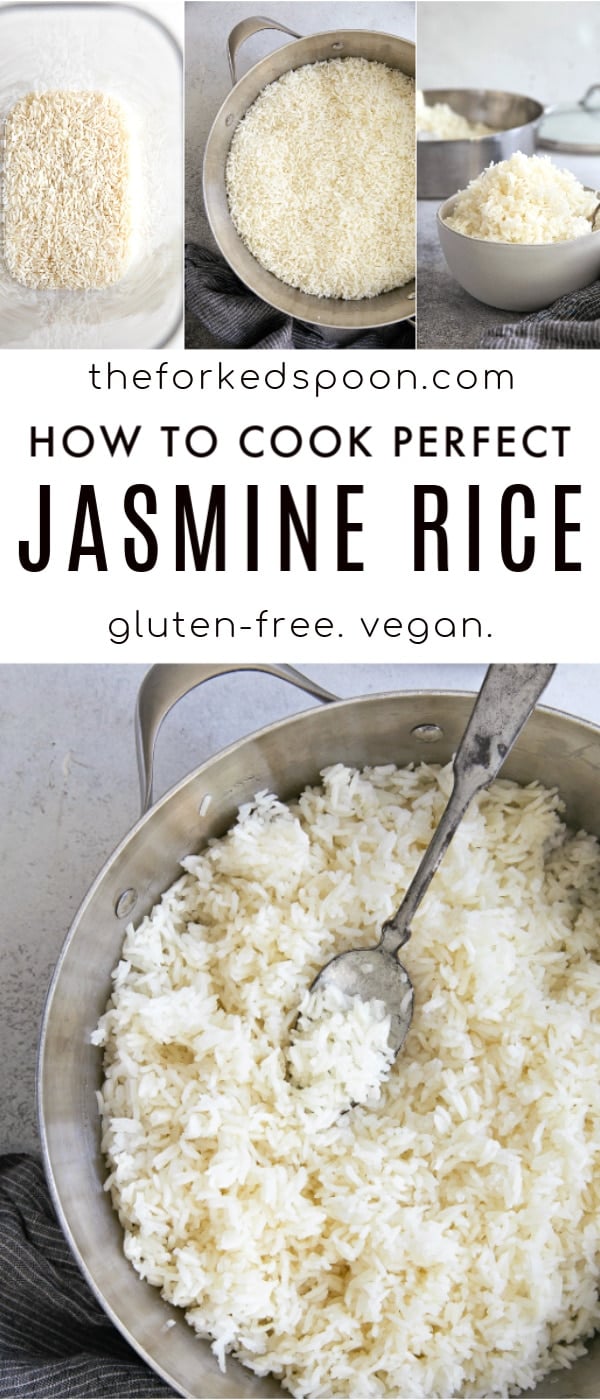





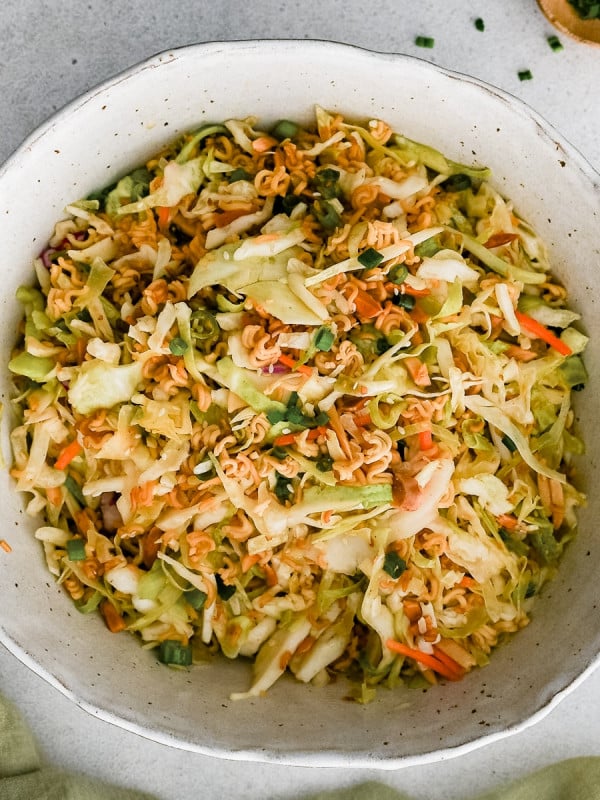









Great and flavorful rice! My first time using Jasmine Rice and I’m sold. I followed the recipe as written, but added a little sesame oil at the end. Will definitely make again. This went well with my Honey Garlic Chicken. Thanks for sharing!
Thanks for the feedback and rating, Shae 😀
I’m shocked! After many tries finally it’s perfect🙌
Jessica, thank you so much, right now I’m cooking your butter chicken🔥
I’m newcomer in your blog and so excited, the next one is Pho🫶
Thanks for the perfect feedback and rating, Valentina 😀
You’re NOT suppose to wash Jasmine rice.
Thank you so much for this method of proper water measurement! I did not have time to do the optional toasting method so I will try that next! This recipe made delicious fluffy jasmine rice. A few questions please.
1) I more routinely cook with Basmati rice. Would the water ratio be the same?
2) I added a teaspoon of distilled white vinegar to minimize stickiness – do you think it helps?
3) I wrapped lid in a linen dish cloth while resting to absorb moisture and reduce stickiness the way Persian rice is made. Do you think it helps?
Thanks for the great feedback, Maristar 🙂
1. See my Basmati Rice Recipe
2. I have not tested that, so I am not sure.
3. It can, as that’s the way my Indian mother-in-law cooks her Basmati Rice.
Your recipe does not say how many portions are served from this quantity. Please advise.
The servings in the recipe card show that this recipe makes 3 cups of cooked rice 🙂